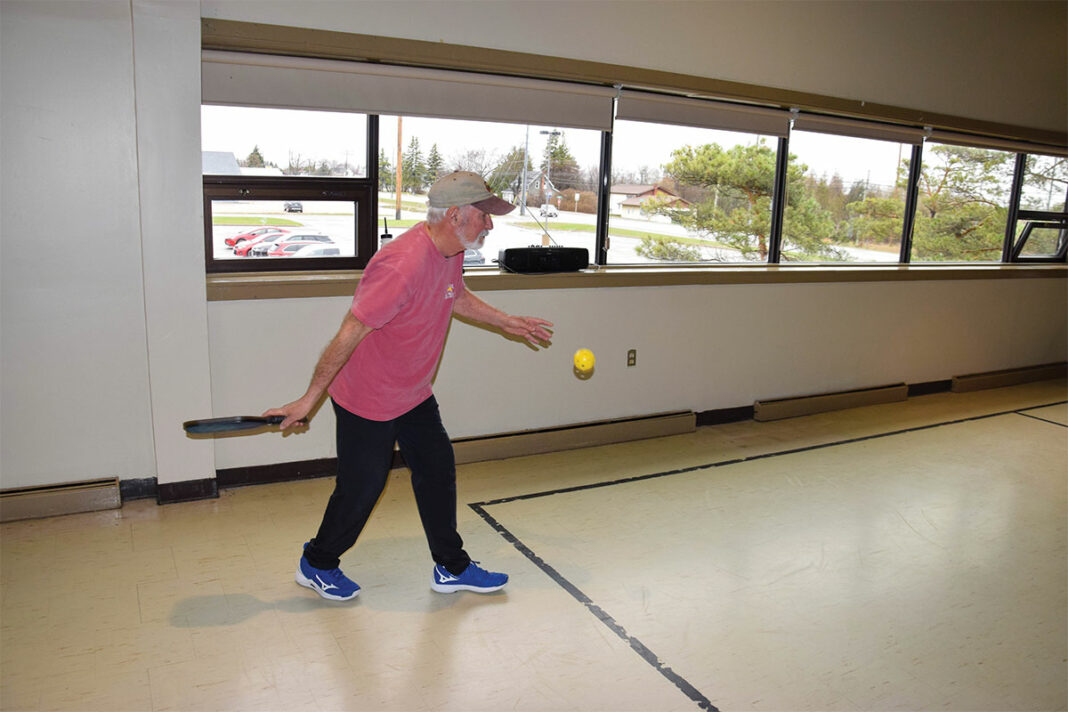LITTLE CURRENT—Pickelball is gaining popularity by leaps and bounds—probably in part because its leaps and bounds are kinder to back, knees and elbows than its distant cousin tennis and more active than its other cousin badminton.
“Since its inception in 2009, the Manitoulin Pickleball Club has been dedicated to providing a welcoming environment for active adults of all skill levels, offering opportunities for fun, fitness and camaraderie,” noted Gary Wolfe as he took a moment out from playing in the upstairs hall courts at the NEMI Recreation Centre. “With a focus on inclusivity and sportsmanship, the club has grown to become a cornerstone of the Manitoulin Island community, attracting players from across the region,” continued Mr. Wolfe.
The pickleball crew are looking forward to their summer season, where they will once more be able to play outdoors on the four outdoor courts set up on the tennis court area, or the five indoor courts in the curling club rink floor.
“We have ample space for our members, old and new, to enjoy their game come rain or shine,” said Mr. Wolfe.
A pickleball net height is set at 36” at the sideline and 34” at the centre. Pickleball is most often played as doubles with four players, two on each team (though singles are possible as well). Each player stands to the right and left of the centerline. You can hit two types of shots: groundstrokes, which hit off the bounce, often from the baseline and volleys, which are hit out of the air from a position closer to the net.
Each side has a seven-foot area called the non-volley zone, or ‘kitchen’, where no player can hit volleys from. Not even a toe can touch the kitchen line during a volley (more on that later).
The first rule of play is that each rally starts with the serve. The player on the right side of the court, facing their opponents, starts the serve. The player serves diagonally to their opponent in the right or left service area. The serve must clear the kitchen (including the line) to count.
The second rule is that the serve must be underhand—no, not sneaky, a pickleball serve must be hit with an underhand stroke or backhand with contact below the waist. The arm must move in an upward arc when striking the ball. A player can either hit the ball out of the air or drop the ball on the ground and hit it.
The goal of the pickleball serve is to put the ball in play. This is quite different from a tennis serve, where the goal is to serve overhand aggressively to win the point.
Each point continues until a fault occurs. In pickleball, there are three basic types of faults: the serve does not clear the kitchen (including the line); a shot is hit out of bounds—landing behind the baseline or outside the sideline; or a shot is hit into the net. Note there is no “let” in pickleball—so, if a serve hits the net, there’s no redo. The ball is played as it lands (so long as it lands within the service area).
A player also cannot volley in the kitchen—the seven-foot zone on each side marks the non-volley zone, or ‘kitchen.’ That means no shot hit out of the air while having any part of your body in the kitchen—or even on the kitchen line. And you can’t let your momentum carry you into the kitchen after a volley either. Players at the net have a big advantage. They can hit any ball high enough with a downward smash and that shot puts opponents immediately on the defensive. Pickleball’s inventors learned that standing right at the net made volleying too easy. It was an unfair advantage and took the fun away (for the defenders at least), so the ‘kitchen’ was born.
If your opponent hits a short shot landing in the kitchen, you can enter and hit from the kitchen. Dinks are a defensive shot and one of the most important parts of pickleball strategy. Often a player’s best move after moving into the kitchen to field a dink is to dink right back to your opponent’s kitchen.
The ball must bounce on both sides before either team can volley, the ball must bounce once on each side (known as the ‘double bounce rule’). This means if your partner is serving and you start up at the kitchen, you’re in a dangerous position because the returning team can hit a shot right at you, and if you react with a volley, that’s a fault. You lose the point.
A player can only win points on their serve. In pickleball, you only win points on your serve, and you continue serving until you lose a rally. After winning each point on your serve, you switch sides with your partner and serve to the other opponent.
In each turn, both players (in doubles) get the opportunity to serve. And in pickleball scoring, you’ll hear players announce three numbers, “Zero, zero… two.” The third number tracks which of the two players on a team has the serve.
Following all the rules above, the game continues until one team gets 11 points, but a team must win by two points. So, if a game’s tied 10-10, the next score doesn’t win. The game continues past 11-10. This rule can have games on for a long time—but players advise those games are often the most fun.
And that is the biggest rule of all—to have fun.
The club is very welcoming and accessible and only requires membership after two guest visits to try it out. After that it is an affordable $2 per session. Speaking of which, the sessions take place Monday, Wednesday and Friday in the morning (9 am to 12 pm) and in the evening Tuesday and Thursday, from 6 to 8 pm.





